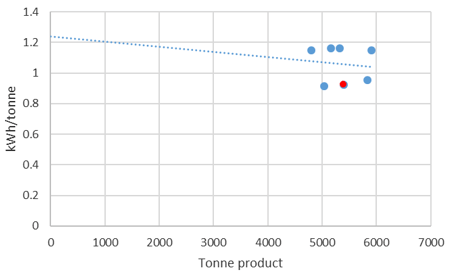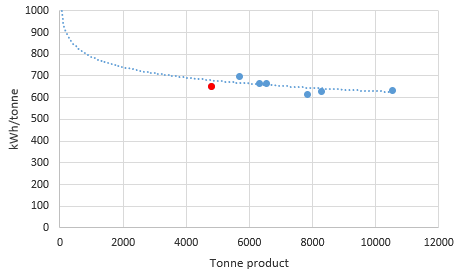Energy Efficiency
In early 2013, a global energy efficiency program was launched, as part of ICL’s corporate-wide ACE (Ambition Creates Excellence) efficiency program. For this purpose, the company developed a standard methodology to be applied in all locations, that includes creating an energy efficiency skill base within the company.
The ACE program frequently delivers significant operational and maintenance savings as well as quality improvements beyond its core environmental aims of reducing fuel and electricity consumption, as well as GHG emissions.
By the end of 2019, 28 of ICL’s largest production facilities around the world implemented this methodology. A total of 31 sites conducted the ACE process by the end of 2019 (three of which have since been divested). During 2020, two additional sites are due to implement the methodology. Other sites are being re-visited to refresh local teams and procedures and to identify new energy efficiency opportunities. The program is well established as ICL’s principal means of improving energy efficiency.
The main efficiency projects implemented to date include:
- Optimizing the control and use of equipment used in production processes
- Recovering residual heat in plant stacks for re-use elsewhere
- Widespread adoption of Variable Frequency Drive (VFD) technology to improve both electrical efficiency and process control.
- Greater efficiency in the production of key utilities, including compressed air, vacuum and steam
- Deployment of advanced control systems for automatic shutdown of unused equipment and air-conditioning systems
- Widespread rollout of LED lighting technologies
In addition, ICL actively improves the awareness and behaviour of employees at all levels of the organization regarding energy use and avoiding waste.

As part of the ACE program, the company is implementing new and improved mandatory internal energy management systems. Individual ICL sites are either accredited to ISO 50001 by external accreditors (mandatory at ICL’s largest energy consuming sites) or by an internal Energy Management System assessed by an internal verification panel (usually small and medium energy consuming sites). All major energy consuming sites will be accredited to ISO 50001 or the internal standard by 2020. ICL sites which have been accredited to ISO 50001 by the end of 2019 include all three ICL Dead Sea sites (DSW, DSB, Bromine-Chlorine) all three ICL Rotem sites (Rotem, Zin, Oron), ICL Neot-Hovav, ICL Rotem Periclase, three sites in ICL Germany (Bitterfeld, Ladenburg, Amfert Ludwigshafen), two sites in ICL Netherlands (Terneuzen and Amfert Amsterdam) and ICL China Lian Yun Gang. The sites already accredited to ISO 50001 form together 35% of all production sites, but are accountable for approximately 75% of ICL global energy consumption. A further 5 ICL sites are due to be accredited by 2020, increasing the ISO 50001 coverage to over 80% of global consumption.
In 2020 ICL has also issued an updated Energy Policy, which applied to all global production sites. The policy focuses on the Energy Efficiency practices and management systems described in this page, while the recent update also details ICL’s steps towards renewable energy implementation.
Throughout 2020 the ICL ACE process is also integrating regular monitoring and reporting of GHG reductions for implemented and proposed energy savings project, in addition to the already monitored energy (MWh) and monetary KPIs. The current goal is to have all major projects analysed for their GHG impact in 2021. This step was undertaken as part of ICL’s enhanced recent goals in terms of GHG reduction and climate change mitigation.
Success Matrices
ICL’s ACE energy efficiency plan has so far reduced energy expenses by approx. USD 75 million overall in 2013-19, compared to the 2012 base year. The specific savings in 2019 were approximately USD 12 million, compared to 2018. The current goal is to achieve a further USD 8 million of savings in 2020, compared with 2019. Cumulative energy savings since the Energy Centre of Excellence began operating in 2005 are estimated at approximately USD 180 million (not including savings from the transition to natural gas).
Some energy cost saving initiatives do not necessarily reduce the actual quantity of energy consumed. For example: adapting production and/or maintenance schedules to increase usage of lower tariff energy supplies or converting from fuel oil to natural gas.
ICL's goal is to achieve a year-by-year improvement of energy intensity, in over 50% of all product-based intensity KPI's.
To make sure the ACE plan delivers reductions in energy terms, and as part of the requirements of ISO 50001, ICL uses product-based energy intensity Key Performance Indicators (KPI’s). These KPI’s, measured in terms of MWh/tonne produced, are tracked for our main products. However, the energy consumption of a production line does not frequently correlate directly to production. Possible reasons can be:
- Product mix: Some of our product lines produce a wide and changing diversity of products every year, each with its own energy intensity, depending on customer demand and other ‘external’ market forces outside of ICL’s control.
- Production volumes: some energy needs are fixed and not dependent on production volume. Therefore, in most cases, higher volume production creates lower energy intensity. Therefore, ICL strives to maximize batch volumes, but this is dependent on customer requirements.
- Weather: some sites are located in exceptionally hot or cold regions. Therefore, significant seasonal variations in energy consumption occur due to weather conditions.
For each product monitored, ICL creates an energy intensity curve based on long-time performance (see examples below). In these examples, the blue data points are historical averages from previous years and the red data points illustrate data for the most recent quarter. An improvement in the KPI is achieved if the quarterly reported intensity is below the nominal curve, and a setback is considered if the intensity is located above the curve.


The goal is to achieve a year-by-year improvement in over 50% of all product-based intensity KPI’s. In 2019, 34 of 63 products (54%) showed annual average improvement, achieving the annual target.
In 2019, 54% of products showed an annual average improvement.
Cooperating with external partners in Neot-Hovav for energy efficiency
Improving Energy efficiency can go beyond ICL’s operational boundaries, and include external partners- working together with ICL for energy savings. Ramat-Negev energy is a privately owned natural-gas based power plant, located in Neot-Hovav, nearby to the ICL Bromine Compounds site. Since early 2019, ICL Neot-Hovav has been purchasing low-pressure steam from Ramat-Negev energy. This steam is a by-product of the electricity generation process in Ramat-Negev, and was previously not used for additional needs. The new externally purchased steam replaces the most of the steam that ICL Neot-Hovav previously generated in its own boilers, significantly reducing the site’s natural gas consumption. For Ramat-Negev, the increased usage of their steam increases the plant’s energy conversion efficiency, and it is now considered a CHP (combined heat and power) plant. The combined effect of the two sites collaboration is a significant increase in their overall efficiency, and a reduction in their shared GHG’s and other emissions.
Energy in the Making - Using hydrogen by-product as fuel
In ICL’s Dead Sea site, the Bromine - Chlorine plant produces Bromine and Chlorine for various industrial needs. During the chemical production process, hydrogen is created. Until recently, the hydrogen that was not used in the production process, or sold as compressed hydrogen, was released to the atmosphere. As part of an overall air emissions reduction initiative that required the incineration of certain gases, it was decided to use the hydrogen by-product as fuel (which has no emissions other than water vapor), instead of natural gas (a fossil fuel). This enabled the Bromine-Chlorine plant to reduce its air emissions without adding emissions that occur when burning fossil fuels.
